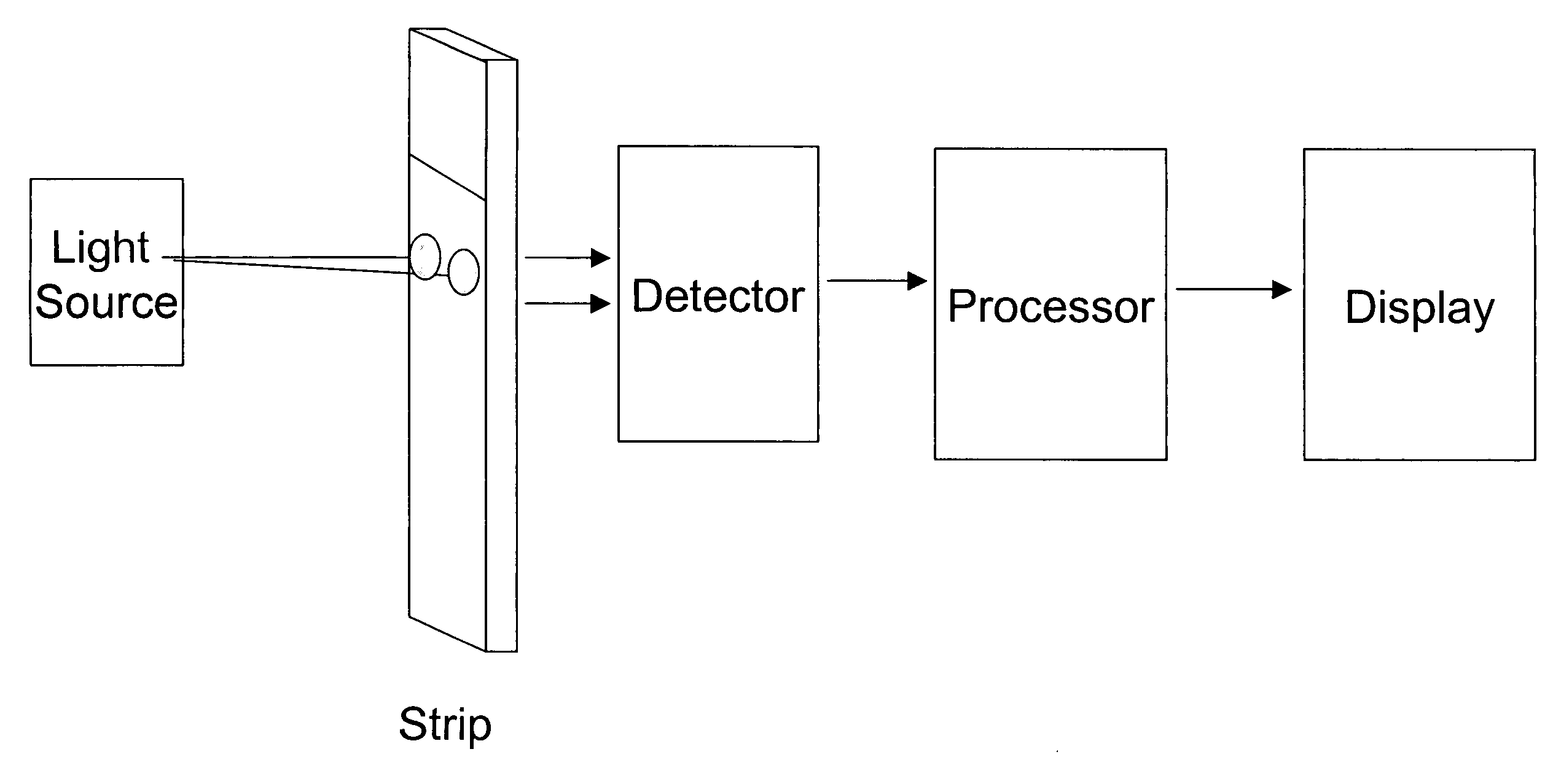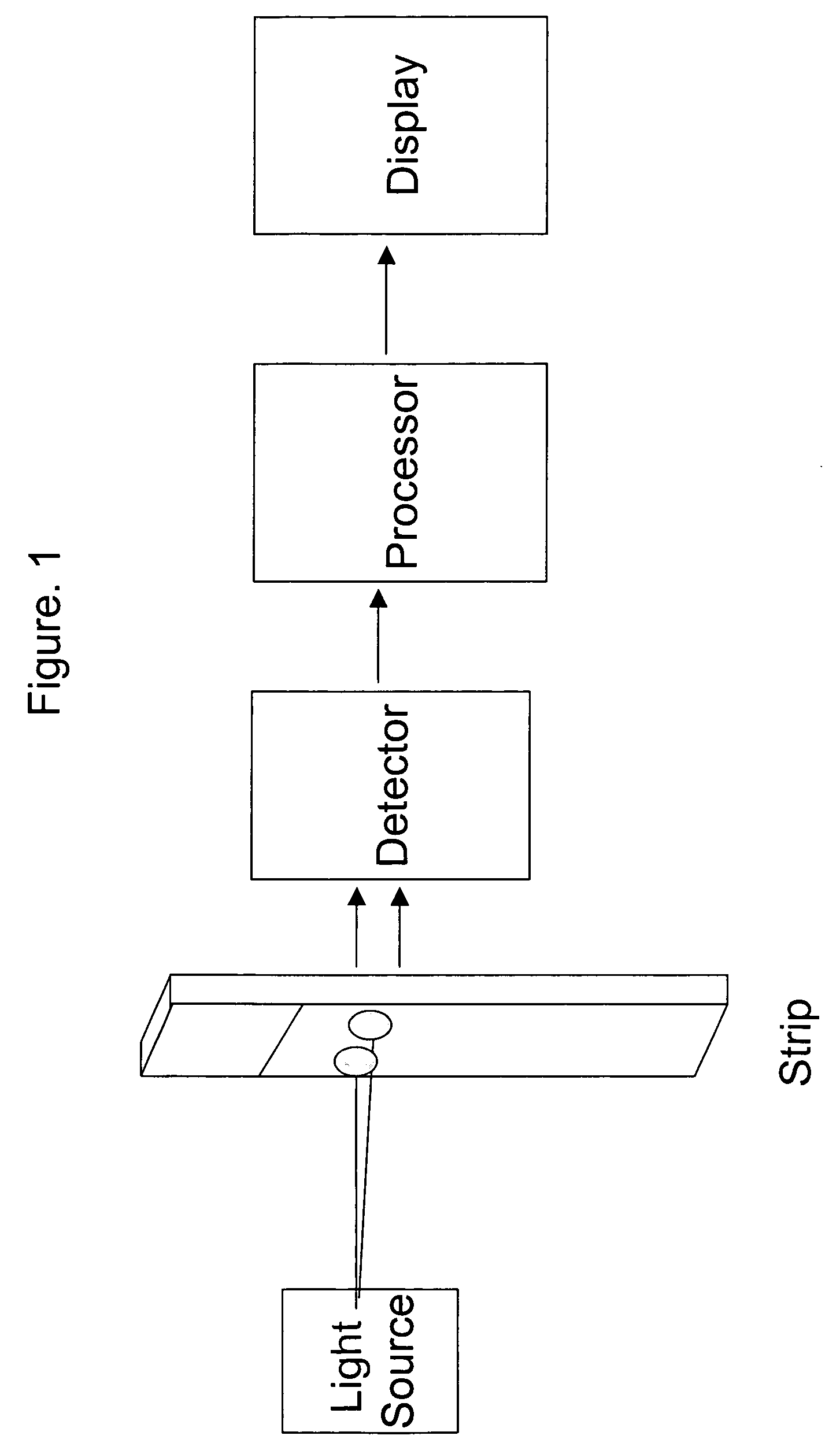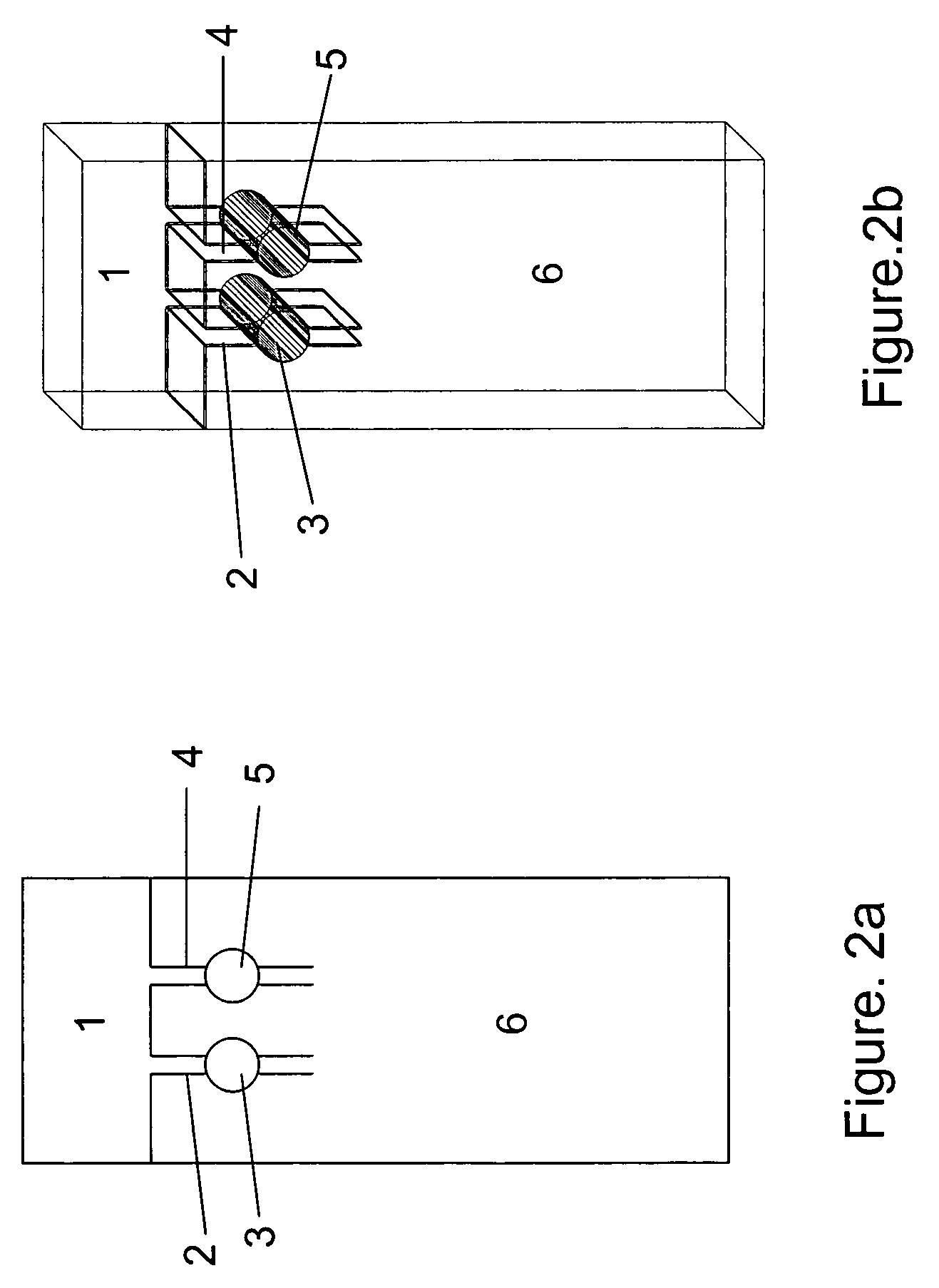Combining transmittance detection and chromatographic strip techniques for quantification of analyte in biological fluids
a technology of chromatographic strip and transmittance detection, which is applied in the direction of analytical using chemical indicators, laboratory glassware, instruments, etc., can solve the problems of complex test procedures, limited sensitivity of reflectance biosensors, and need special equipment, so as to simplify the test process and achieve good sensitivity , the effect of high sensitivity
- Summary
- Abstract
- Description
- Claims
- Application Information
AI Technical Summary
Benefits of technology
Problems solved by technology
Method used
Image
Examples
examples
Test Strip used in the Experiment (One Detection Cell Only, FIG. 3)
[0034]The dry strip has a dimension of 1.58×0.35×0.041 inch. Frame 15 of the strip is made with Mellinex plastic. The frame itself is 0.075 inches width each side. The detection cell, that is: capture zone 16 is 0.2×0.2×0.035 inch dimension. Both ends 12 and 13 of the cell are framed with porous plastic from Porex to hold the beads between, but permit fluid flowing through. Both front and back of the strip are glued with a 0.003 inches of Mylar transparent membrane to hold the beads in the detection cell and allow the light transmission through the detection cell. The absorbent pad fills the space of the strip 14 to absorbing fluid. Agarose beads covalently linked with the affinity reagent—boronic acid from Pierce are packed into the detection cell 16.
[0035]Experiment 1 (Quantitation of Glycated Hb) The samples from Aalto Scientific were used for this study. The glycated Hb values of used samples first were determine...
experiment 3 (detection of the amount of ghb by their peroxidase activity) alternative way to determine the amount of glycated hb and total hb is to measure their peroxidase activities.when glycated hb binds to the beads in the detection cell , the heme in glycated hb oxidizes or reduces the substrate and produces a visible color product.the product absorbs light at a selected wavelength.the samples with different levels of glycated hemoglobin were diluted with a sample buffer to 1 : 50 , 000.the 200 ul of dilution was added to the sample application well , and the strip was further washed with 200 ul of buffer washing away the non bound hb.200 ul of tmb membrane peroxidase substrate solution from kpl was applied to the sample well and as it flowed down a color product developed in the cell , which was proportional to the ghb bound to the beads (fig.6)
Experiment 3 (Detection of the Amount of GHb by their Peroxidase Activity) Alternative way to determine the amount of glycated Hb and total Hb is to measure their peroxidase activities. When glycated Hb binds to the beads in the detection cell, the heme in glycated Hb oxidizes or reduces the substrate and produces a visible color product. The product absorbs light at a selected wavelength. The samples with different levels of glycated hemoglobin were diluted with a sample buffer to 1:50,000. The 200 ul of dilution was added to the sample application well, and the strip was further washed with 200 ul of buffer washing away the non bound Hb. 200 ul of TMB membrane peroxidase substrate solution from KPL was applied to the sample well and as it flowed down a color product developed in the cell, which was proportional to the GHb bound to the beads (FIG. 6). The color intensity was determined same way as in experiment 1 and 2.
experiment 4 (detection of the amount of igg-hrp conjugates using chromatographic strip) a 1 : 2000 dilution (pbs) of igg-hrp conjugate (mouse igg-hrp from pierce) was prepared.5 , 10 , 15 , 20 , 25 , and 30 ul of diluted igg-hrp conjugate were mixed with 1 ml of pbs respectively.100 ul of the mixture was applied to the sample well and flowed down to the detection cell.then 200 ul of the membrane peroxidase substrate-tmb was added to the sample well.a color product developed as the tmb substrate solution flowed through the detection cell to the absorbent part of the strip.the color intensity is proportional to the amount of igg-hrp conjugate on the bead (fig.7)
Experiment 4 (Detection of the Amount of IgG-HRP Conjugates using Chromatographic Strip) A 1:2000 dilution (PBS) of IgG-HRP conjugate (mouse IgG-HRP from Pierce) was prepared. 5, 10, 15, 20, 25, and 30 ul of diluted IgG-HRP conjugate were mixed with 1 ml of PBS respectively. 100 ul of the mixture was applied to the sample well and flowed down to the detection cell. Then 200 ul of the membrane peroxidase substrate-TMB was added to the sample well. A color product developed as the TMB substrate solution flowed through the detection cell to the absorbent part of the strip. The color intensity is proportional to the amount of IgG-HRP conjugate on the bead (FIG. 7).
PUM
| Property | Measurement | Unit |
|---|---|---|
| width | aaaaa | aaaaa |
| pH | aaaaa | aaaaa |
| concentrations | aaaaa | aaaaa |
Abstract
Description
Claims
Application Information
 Login to View More
Login to View More - R&D
- Intellectual Property
- Life Sciences
- Materials
- Tech Scout
- Unparalleled Data Quality
- Higher Quality Content
- 60% Fewer Hallucinations
Browse by: Latest US Patents, China's latest patents, Technical Efficacy Thesaurus, Application Domain, Technology Topic, Popular Technical Reports.
© 2025 PatSnap. All rights reserved.Legal|Privacy policy|Modern Slavery Act Transparency Statement|Sitemap|About US| Contact US: help@patsnap.com



